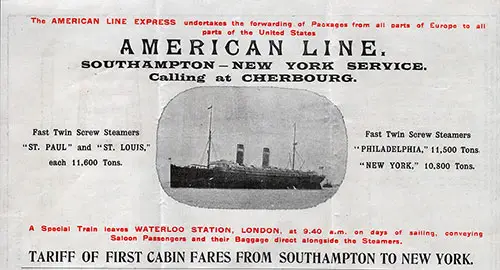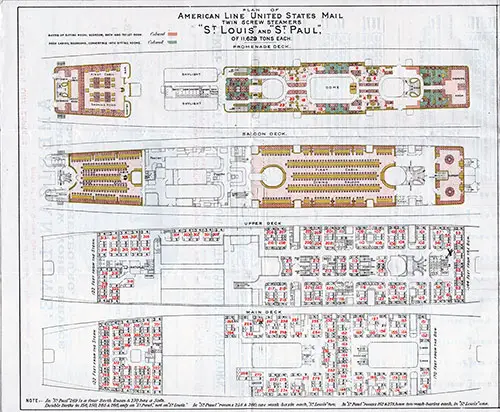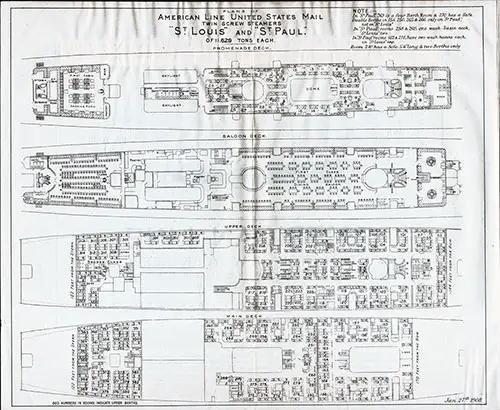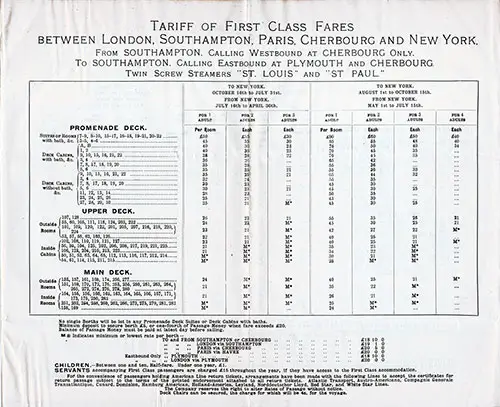SS St. Louis Archival Collection
Content Links
- St. Louis (1895) American Line
- St. Louis (1929) Hamburg-American Line
- Passenger Lists
- Brochures
- Passage Contracts, Tickets, and Receipts
- Deck Plans
- Passage Rates
- Other Ephemera
- Sailing Schedules
- Photographs
- Books
- The New Ocean Steamers St. Louis and St. Paul - 1894
- Description of the SS St. Louis - 1896
St. Louis (1895) American Line
Built by Wm. Cramp & Sons Shipbuilding & Engineering Co., Philadelphia, Pa. Tonnage: 11,629. Displacement of 16,000 tons. Dimensions: 535' X 63' (554' o.l.). Propulsion: Twin-screw, 21 knots. Quadruple expansion engines. 20,500 I.H.P. Masts and Funnels: Two masts and two funnels. Steel hull. Launched: November 12, 1894. Equipped with ten boilers, which had a total of 64 furnaces. Passengers: 320 first, 210 second, 800 third. Maiden voyage: New York-Southampton, June 5, 1895. Renamed: (a) Louisville (1917) United States Government, (b) St. Louis (1920). WW1 Service: Served as a troopship in First World War. Fate: She caught fire while refitting in 1920. The scuttled liner was refloated, but the rusting burned-out liner remained tied up in New York for four years. Finally towed to Italy to be dismantled by shipbreakers in 1925. 1924-25. Sister ship: St. Paul.
St. Louis (1929) Hamburg-American Line
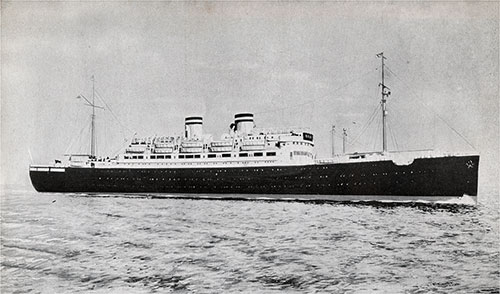
The Motorship St. Louis of the Hamburg America Line. Go Tourist Class Brochure, 10 February 1936. | GGA Image ID # 1262697dbb
Built by Bremer Vulkan, Vegesack, Germany. Tonnage: 16,732. Dimensions: 543' x 72' (574' o.l.). Propulsion: Twin-screw, 16 knots. Motorship. Masts and Funnels: Two masts and two funnels. Passengers: 270 cabin, 287 tourist, 416 third. Service: Hamburg-Cobh- Halifax-New York. At times used as a cruise ship. WWII: Severely damaged by air attacks at German port in August 1944. Post War Service: The battered liner was used as a hotel ship at Hamburg after the war. Fate: Broken up for scrap in 1950. Sister ship: Milwaukee.
Passenger Lists
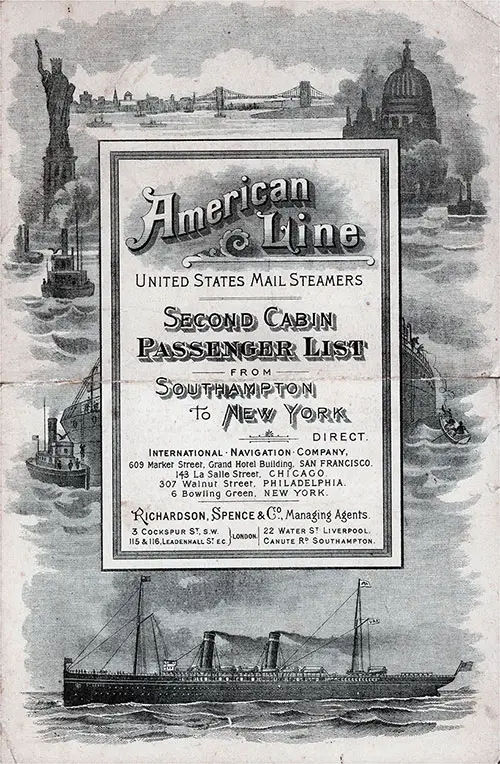
1897-10-02 SS St. Louis Passenger List
Cabin Passenger List for the SS St. Louis of the American Line, Departing Saturday, 2 October 1897 from Southampton to New York, Commanded by Captain William G. Randle.
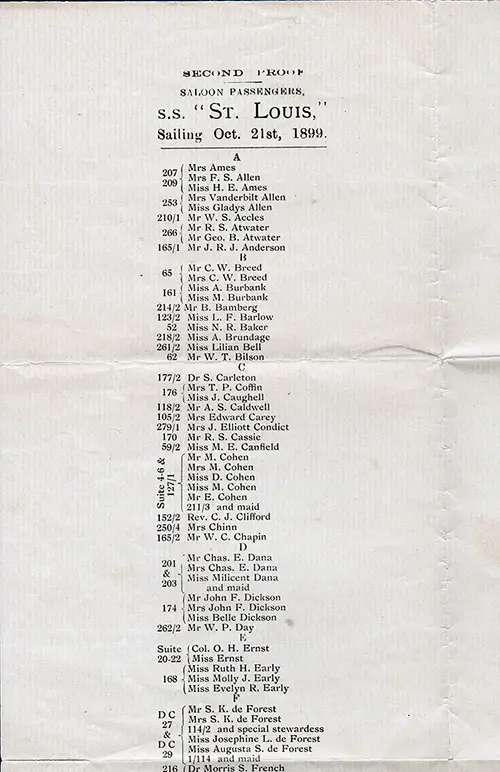
1899-10-21 SS St. Louis Passenger List
Saloon Passenger List for the SS St. Louis fo the American Line, Departing Saturday, 21 October 1899 from Southampton to New York, Commanded by Captain William G. Randle.

1901-05-25 SS St. Louis Passenger List
Cabin Passenger List for the SS St. Louis of the American Line, Departing Saturday, 25 May 1901 from Southampton to New York via Cherbourg, Commanded by Captain F. M. Passow. Arrived in New York on 1 June 1901.

1901-09-04 SS St. Louis Passenger List
Cabin Passenger List from the SS St. Louis of the American Line, Departing 4 September 1901 from New York to Southampton, Commanded by Captain W. J. Roberts.

1907-10-26 SS St. Louis Passenger List
First Class Passenger List for the SS St. Louis of the American Line Sailing from Southampton to New York via Cherbourg on Saturday, 26 October 1907. Commanded by Captain John C. Jamison.

1911-09-23 SS St. Louis Passenger List
First Class Passenger List for the SS St. Louis of the American Line, Departing Saturday, 23 September 1911 from Southampton to New York via Cherbourg, Commanded by Captain John C. Jamison.

1912-09-21 SS St. Louis Passenger List
First Class Passenger List for the SS St. Louis of the American Line, Departing Saturday, 21 September 1912 from Southampton to New York via Cherbourg, Commanded by Captain John C. Jamison. Arrived in New York on 28 September 1912.

1915-05-29 SS St. Louis Passenger List
Second Class Passenger List for the SS St. Louis of the American Line, Departing Saturday, 29 May 1915 from Liverpool to New York, Commanded by Captain John C. Jamison.

1917-10-31 SS St. Louis Passenger List
First and Second Class Passenger List for the SS St. Louis of the American Line, Departing Wednesday, 31 October 1917, from Liverpool to New York, Commanded by Captain H. Hartley.
Return to Content Links
Brochures
1901-04-22 American Line First Cabin Services
1901 Brochure covers First Cabin Travel on the Steamships of the American Line and includes Deck Plans, Rates for Transatlantic Travel (Southampton - New York Service via Cherbourg) and General Passenger Information. Ships Covered: St. Louis, St. Paul, and New York.
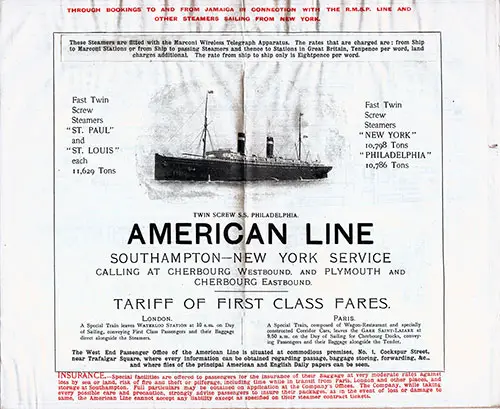
American Line Southampton to New York Service - 1908
Broadside Flyer produced by the American Line promoting their Southampton - New York service. Includes information for passengers, the tariff of first-class fares, and deck plans for the SS St. Louis, SS St. Paul, SS New York, and the SS Philadelphia.

HAPAG-North German Lloyd - Go Tourist Class - 1936
26-Page Brochure "Go Tourist Class" is a joint production of HAPAG-NDL. Profusely Illustrated with interior photographs of Tourist Class accommodations and ships of both lines that carried passengers of that class. A superb brochure produced for American tourist of the Summer Olympic Games in Berlin, Germany. Bremen, Europa, Columbus, Berlin, New York, Hamburg, Deutschland, Hansa, and St. Louis

HAPAG-NDL Ships in the Transatlantic Service - 1937
14-page small format brochure produced jointly by HAPAG-LLOYD welcomes you to Germany in 1937 on their transatlantic ships Bremen, Europa, Columbus, New York, Hamburg, Hansa, Deutschland, St. Louis, and Berlin. Brief information along with a photograph of each ship is included in this booklet.

HAPAG - Cabin and Third Class on the MS St. Louis - 1938
1938 8-page, large format brochure from the Hamburg America Line presents views of the rooms and decks enjoyed by the cabin and third-class passengers aboard the MS St. Louis. Captions and text were provided in German and English. The English versions are provided below.
Return to Content Links
Passage Contracts, Tickets, and Receipts

SS St. Louis Prepaid Memorandum - 2 October 1897
1897 Memorandum (Ticket Receipt) for a Prepaid Second Cabin passage on the American Line Steamship St. Louis for Passenger R. L. Laplace. The GG Archives also has the passenger list for the voyage this ticket was purchased for (1897-10-02 SS St. Louis Passenger List).
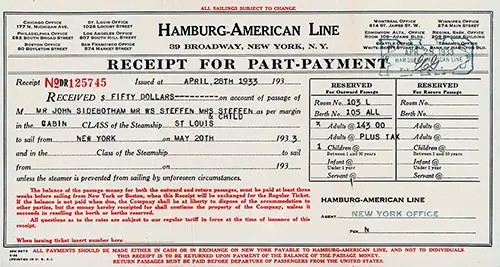
💼 A Fare to Hamburg: 1933 SS St. Louis Cabin Class Passage Receipt
The Hamburg America Line’s Receipt for part-payment of a cabin class voyage aboard the SS St. Louis provides a rich and nuanced window into the world of transatlantic travel during a tense pre-WWII era. Dated 28 April 1933, this receipt serves as a tangible link to an era marked by economic struggle, rising political tension, and the enduring human desire for connection across borders.
Return to Content Links
Deck Plans
Deck Plan of the SS St.Louis and the SS St. Paul of the American Line. Dated 22 April 1901. | GGA Image ID # 1144aedaba. Click to View Larger Image.
Deck Plans of American Line United States Mail Twin Screw Steamers "St. Louis" and "St. Paul" of 11,629 Tons Each. Diagram Includes Promenade, Saloon, Upper, and Main Decks. Dated 27 January 1908. | GGA Image ID # 11492171b6. Click to View Larger Image.
Return to Content Links
Passage Rates
Tariff of First Class Fares Between London, Southampton, Paris, Cherbourg and New York. From Southampton. Calling Westbound at Cherbourg Only. To Southampton. Calling Eastbound at Plymouth and Cherbourg. Twin Screw Steamers "St. Louis" and "St Paul" - 1908. | GGA Image ID # 11498fa506. Click to View Larger Image.
Return to Content Links
Other Ephemera
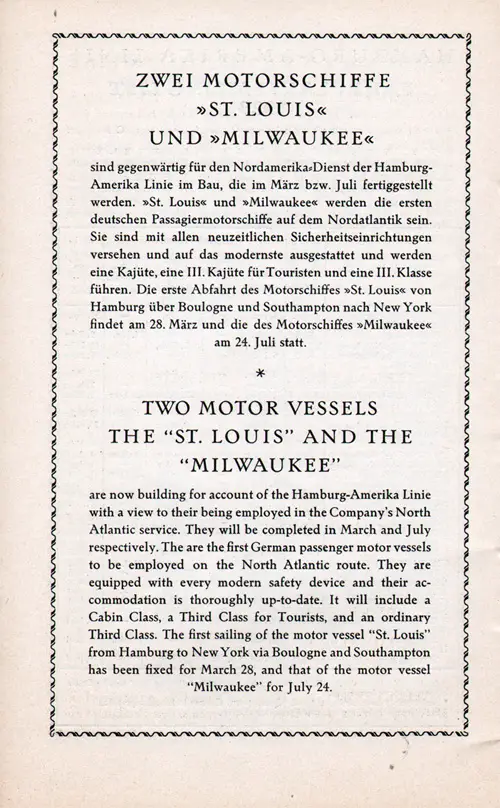
The SS St. Louis and the SS Milwaukee are being built by the Hamburg-American Line for Their North Atlantic Routes. SS New York Passenger List, 16 January 1929. | GGA Image ID # 1dcd2e850d
Return to Content Links
Sailing Schedules
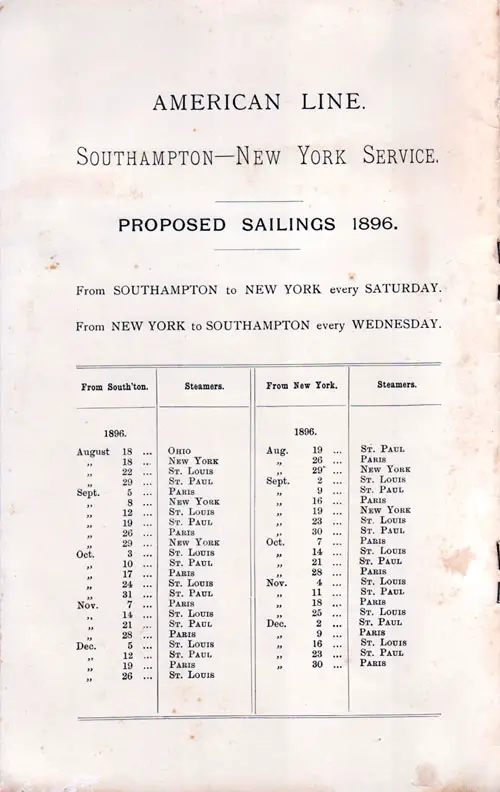
Sailing Schedule, Southampton-New York Service, from 18 August 1896 to 30 December 1896. Ships Included the Ohio, New York, Paris, St. Louis, and St. Paul. SS Paris Passenger List, 15 August 1896. | GGA Image ID # 1e449f2aad
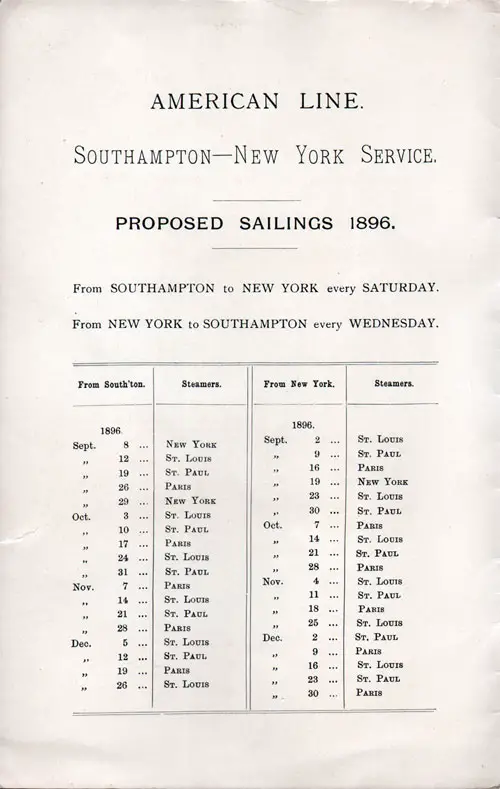
Sailing Schedule, Southampton-New York Service, from 8 September 1896 to 30 December 1896. Ships Included the New York, Paris, St. Louis, and St. Paul. SS Paris Passenger List, 5 September 1896. | GGA Image ID # 1e44bce4ca
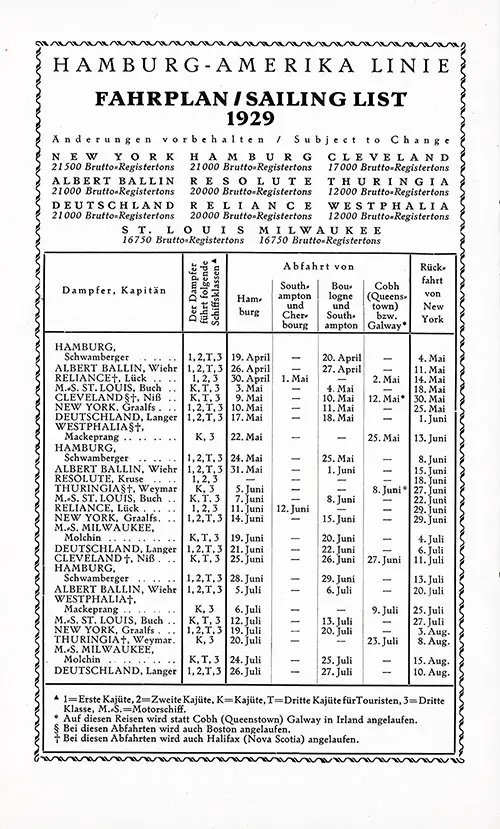
Proposed Sailing List, Hamburg-Boulogne sur Mer-Southampton-New York, from 19 April 1929 to 15 August 1929. Ships Included the Albert Ballin, Cleveland, Deutschland, Hamburg, Milwaukee, Reliance, Resolute, St. Louis, Thuringia, and Westphalia. SS Hamburg Passenger List, 19 April 1929. | GGA Image ID # 1e0152e801
Return to Content Links
Photographs
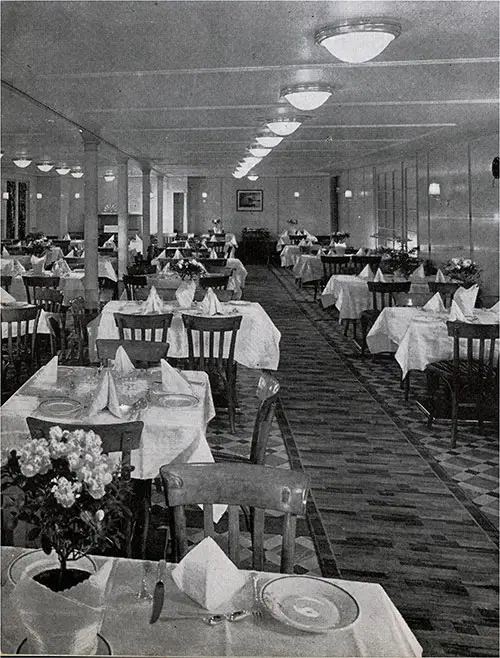
Tourist Class Dining Room on the MS St. Louis. Go Tourist Class - Hamburg American Line and North German Lloyd Brochure, 10 February 1936. | GGA Image ID # 12627c229b
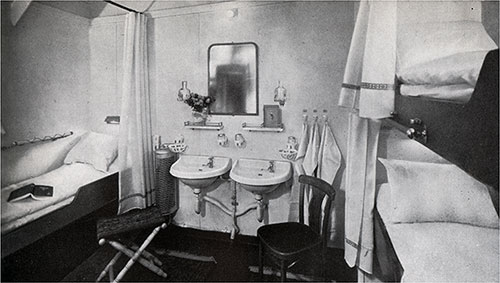
Tourist Class Two-Berth Stateroom on the MS St. Louis. Go Tourist Class - Hamburg American Line and North German Lloyd Brochure, 10 February 1936. | GGA Image ID # 1262b3bed7
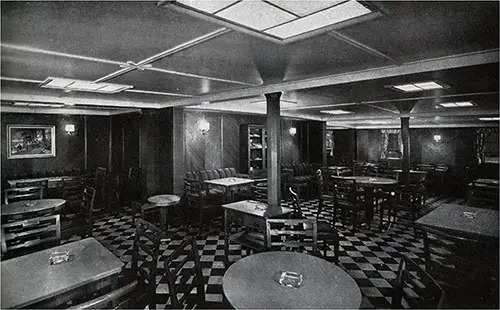
Tourist Class Smoking Room on the MS St. Louis. Go Tourist Class - Hamburg American Line and North German Lloyd Brochure, 10 February 1936. | GGA Image ID # 1262d7f4cd
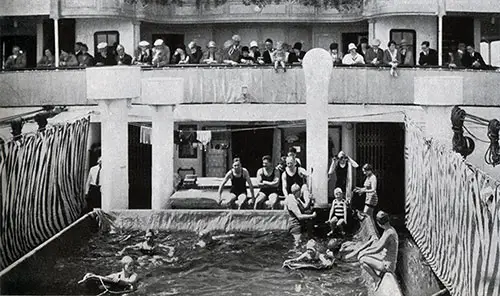
Tourist Class swimming Pool on the MS St. Louis. Go Tourist Class - Hamburg American Line and North German Lloyd Brochure, 10 February 1936. | GGA Image ID # 1262ddd60f
Return to Content Links
Books
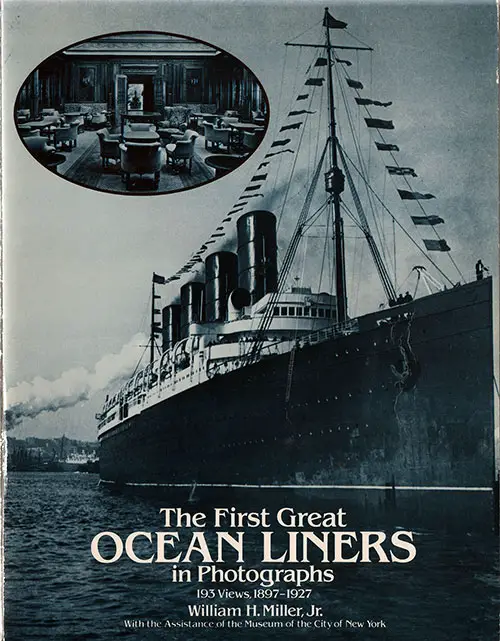
The First Great Ocean Liners in Photographs - 1983
Sumptuous volume recalls the glorious early years of elegant transatlantic travel. Over 190 historic photographs depict exterior and interior views of 101 great ocean liners, including the Virginian, Imperator, Vaterland, Bismarck, Lusitania, Mauretania, Balmoral Castle, Titanic, Olympic, Aquitania and dozens more. Full captions.
Return to Content Links
The New Ocean Steamers St. Louis and St. Paul - 1894
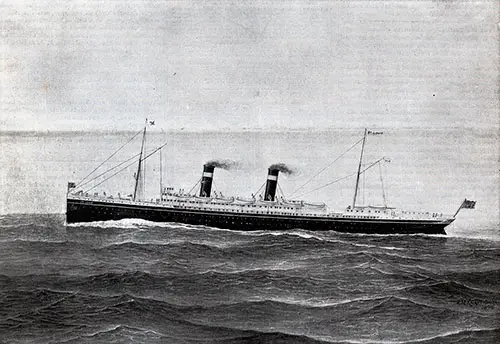
The New American Atlantic Liner St. Louis. Scientific American, 11 August 1894. | GGA Image ID # 13eb90e399
The necessity for the immediate encouragement for the building, by American citizens, of a fleet of ocean steamships, capable of the highest speed, and constructed with special reference to government naval service, in case of war, led the Congress of the United States, in 1892, to enact certain special laws upon the subject.
Authority was given to the International Navigation Company, of Philadelphia, at once to place under the American flag two of its fast English-built vessels, the New York and the Paris, provided others of equal or higher class should be promptly constructed in this country.
Thereupon the company entered into contracts with the Messrs. Cramp, of Philadelphia, for the construction of several new vessels, which are now under construction.
The first two of these, the St. Louis and the St. Paul, are now approaching completion. Herewith we present a drawing of one of these vessels, the St. Louis. The following particulars we derive from the Steamship :
The St. Louis and St. Paul are the first transatlantic passenger steamers to be built in the United States for a period of over twenty years, and they will be compared with the most recent productions of British shipbuilders, which represent the culmination of their skill and experience.
They are the largest vessels ever constructed in America, their principal dimensions being : Length over all, 554 feet; length on load water line, 536 feet; extreme breadth, 63 feet; moulded depth, 42 feet; tonnage, gross register, 11,000 tons.
The hull of each vessel is to have a double bottom constructed on the cellular principle, subdivided by athwartship bulkheads and a longitudinal division arranged for heeling purposes, the whole to be available for water ballast.
In designing these vessels special attention has been given to the question of safety under all conditions. They are so subdivided by transverse bulkheads that even in the event of a collision and injury to a bulkhead, whereby two compartments might fill with water, the ship would still float in perfect safety.
They will have a straight stem and elliptical stern, topgallant forecastle and poop, with close bulwarks fore and aft, two pole masts, and two lofty smoke pipes or funnels.
There will be promenade, saloon, upper, main, and orlop decks, the three first-named to be plated from end to end. The main deck will be plated for the length of the machinery spaces, and will have stringers and tie plates beyond. Wood planking will be laid on all decks.
The promenade deck will remain unbroken the whole length of the vessel. Arrangements have been made in each of the vessels for carrying about 320 first-class and 200 second-class passengers, and 900 emigrants.
The first-class passengers will occupy the center of the vessel, the second class will be between the stern and the center, and emigrants will occupy the ends of the vessel.
The main saloon, which is large enough to seat all the first-class passengers at once, will be on the upper deck forward, and will be arranged with a large dome in the middle, so that the appearance of the interior will be that of an immense hotel dining hall.
The second-class saloon will also be on the upper deck, but toward the after end, and will be fitted up in the ordinary style of a first-class saloon on an Atlantic liner.
The first-class smoking room will be on the promenade deck aft, and will be furnished with everything that experience has taught contributes to the comfort of the passengers. Besides these there will be a library and drawing room, where the ladies and non-smokers may amuse themselves.
The engines of the new steamers will be the most powerful quadruple expansion marine engines in the world. They will probably develop about 10,000 I.HP. each.
The cylinders will be 36, 50, 71 and 100 inches respectively in diameter, with a piston stroke of 60 inches, two sets of engines being placed in each boat to turn the twin screws, which will be sectional with three blades.
Steam for the working of the main engines will be furnished at about 200 pounds pressure by six steel double-ended boilers, each 20 feet long and 15 feet 7% inches diameter; the battery to have 48 Purves furnaces 39 inches diameter, and to be fitted with Serve's patent tubes.
The total grate surface will aggregate about 830 square feet and the heating surface about 30,000 square feet. Piston valves will be fitted throughout and operated in the usual manner.
The crank shafts, eccentric straps and connecting rods will be of forged steel, and the piston rods will be of ingot steel. The valve gear will be of the link type, controlled by a steam cylinder and also by an auxiliary hand gear.
Many features will be added to insure the perfect working of these engines. The columns will be of cast steel forked at bottom. The thrust blocks will be of the usual horseshoe type, and the thrust shafts are to be about 13 feet long. The line shafting will be of forged steel, the bearings being of cast iron. The air pumps will be attached, but the condensers will be independent.
To support the outboard shaft bearings, the hull is built out in a horizontal web to a steel frame, having both bosses cast in one piece, and weighing about 68,000 pounds. The after deadwood is cut away, and the keel slopes up, so that the shoe meets the boss frame at the after end.
To comply with the terms of the contract, the builders will have to show, by an extended sea trial, that when working under ordinary sea-going conditions the vessels are to be easily capable of maintaining a speed of 20 knots per hour at sea.
Of course, the quadruple expansion engines of these twin screw vessels will be the most interesting feature, on account of the great power they are expected to develop.
This is the first time an effort has been made to use quadruple expansion in engines of over 4,000 I. H. P., and in only one or two instances has it been applied to engines of that power. In speaking of the vessels, Mr. Charles H. Cramp, in a paper read before the American Society of Naval Architects and Marine Engineers, said : "I will not venture prediction as to their probable performance, but I will guarantee them to be perfectly safe, comfortable and economical ships.
They are to be closely followed by other ships, which I will not now describe, except to say that they will not shrink from comparison or competition. The St. Louis and St. Paul have been especially arranged so as to be readily and quickly convertible into armed cruisers, carrying eight 6 inch 100 pound rapid-fire guns.
Also, the conditions of the mail contract between the United States government and the International Navigation Company place at the disposal of the American navy these great ships, almost instantly convertible into commerce destroyers, averaging greater performance than the Columbia, which, with the three others that are about to follow as quickly as the plans can be completed, will practically re-enforce the United States navy by $21,000,000 worth of ships and not only without cost of building, but also without the expense of maintenance and commission in time of peace.
In conclusion, allow me to say that these ships will be American from truck to keelson. No foreign materials enter into their construction. They are of American model and design, of American material, and are being built by American skill and muscle.
Source: Scientific American: A Weekly Journal of Practical Information, Art, Science, Mechanics, Chemisty, and Manufactures, Copyrighted 1894 by Munn & Col, Vol. LXXI, No. 6, New York, 11 August 1894. Pages 81+
Return to Content Links
Description of the SS St. Louis - 1896
The SS St. Louis, which is the first of the two vessels being built for the American Line by The William Cramp & Sons' Ship and Engine Building Company, is the first large trans-Atlantic steamer that has been built in this country since the four American boats, Pennsylvania, Indiana, Ohio and Illinois, which were built in the early seventies, and which are now running in the American Line between Philadelphia and Liverpool.
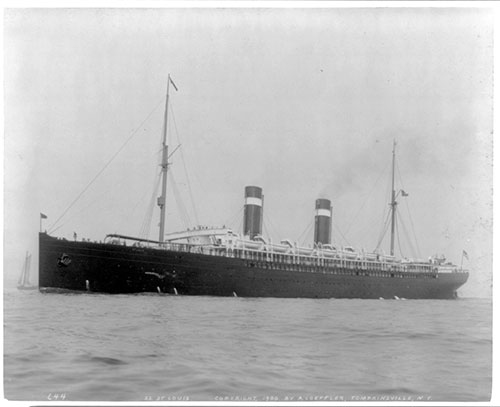
The Amerrican Line Steamship SS St. Louis in New York Harbor, Full, Broadside View, c1896. Photo by A. Loeffler. Library of Congress LCN 2006687009. | GGA Image ID # 1dcd9a9950
The first frames of the St. Louis were raised on the 27th day of July, 1893, taking fifteen months and sixteen days from the beginning of her construction to the time of her launch, during which time something over 6000 tons of steel has been worked into her hull, while the construction of her boilers and machinery has kept equal pace in the engineering department, and they are now ready to be erected on board.
It is worthy of note that these steamships are built of domestic material throughout. They are of American model and design, American material, and they are being built by American skill and muscle.
The principal dimensions and qualities are as follows :—
- Length over all 554 feet
- Length between perpendiculars 535 feet
- Breadth, extreme 63 feet
- Depth molded 42 feet
- Number of decks 5
- Number of Watertight compartments formed by transverse bulkheads and fiats 17
- Distance of collision bulkhead abaft of stem 33 feet
- Displacement at 26 feet draught will be nearly 16,000 tons
The St. Louis has two funnels, two masts and a straight stem, and the hull is carried out aft around the stern tubes forming webs, so to speak, on either side. The shell plating is lap-butted, and the rudder is of the single-plate type. The vessel is so divided by bulkheads that any two, and in some cases three, compartments may be filled with water at the same time without endangering the safe flotation of the ship.
The material used in the construction of this vessel is mild steel of the best quality, and the records of its inspection show an average considerably above Lloyd's standard.
Although the St. Louis is not yet in a sufficiently forward condition to enable one on board to get much of an idea of the internal arrangements, the plans are completed, and the comforts and conveniences provided for the passengers are known. Thus the quarters assigned to the different classes of ocean travelers are clearly defined.
The Accommodations on the St. Louis
The steamship has five decks. On the upper deck, or as the company calls it the saloon deck, is a deck-house extending fore and aft with a passageway 7 feet wide on each side of it between it and the rail on which the traffic of the ship is conducted. The passenger enters this deckhouse at several places, but the principal entrance is just forward the foremost funnel, where a spacious staircase arises to the promenade deck, which is on top of this main-deck house, and descends to the first cabin sleeping cabins on the two decks beneath.
In the hallway surrounding this staircase are the rooms of the purser and chief steward, easily accessible to passengers. The forward end of this hall opens into the library. This is probably the largest reading-room afloat; and is handsomely fitted up in oak, and furnished with bookcases, writing-tables, comfortable seats, and a plentiful supply of books selected from standard literature, for the use of passengers.
The crew quarters, steerage bar, hospitals, mess rooms, etc. occupy the forward end of this deck, or forecastle. The after end of the hall opens direct into the grand dining-saloon, which is thus situated nearly amidships, between the funnels and on the upper deck of the ship, which is a deck higher than is the case in any large trans-Atlantic steamer, excepting the New York and Paris, and three of the other steamers of this company. This room is handsomely decorated, and finished in white mahogany, which gives it a very cheerful, bright appearance.
The Dining Saloon
The Dining Saloon is 110 feet long by 50 feet wide and will seat all the first-cabin passengers at one sitting. It is well lighted from the sides and above from a large dome, in one end of which is an organ, played from a keyboard placed in one end of the saloon. In addition to the saloon being situated amidships, where the motion of the vessel is least appreciable. The tables are arranged in a fore and aft direction, which obviates the discomfort of side motions when the ship is rolling. There is also a companionway on the promenade deck into the lobby at the after end of the saloon, so that if a passenger desires, he can enter from this end.
The pantries on this ship are not easy for a passenger to find, as he does not have to pass and repass them in going to and from his meals, as is often the case. This will be a great comfort to passengers who are inclined to be seasick. In fact, they are situated immediately abaft the saloon, so that the passengers can be promptly and efficiently served.
Engineers' Mess-room and First Cabin Pantry
Abaft the pantries, and between the engine-room skylights, is situated the engineers' mess-room, and abaft this again, but in communication with the first-cabin pantry is the second-cabin pantry which is at the forward end of the second cabin dining-saloon. This room is very large and well lighted.
Second Cabin Dining Saloon
It will accommodate about 200 passengers. The tables are arranged in a fore and aft direction; and chairs instead of the usual settees are provided. Abaft this is situated the doctor's office and dispensary, where it will be accessible to all passengers.
In the after end of the ship is situated crew quarters, steerage, lavatories, hospitals, etc., etc.
The Mail Room
In a house by itself, a very modern feature of the ship, is situated the mail sorting-room and mail clerks' rooms. It is well known that this ship is under contract with the Government to carry the trans-Atlantic United States mail, and everything is most conveniently arranged for this purpose.
The mailroom is situated in the after hold, and is reached by a special hatch for this use only. The mail sorting-room is fitted up as is usually the case in post offices on land and the mail will be sorted there while in transit.
Promenade and Shelter Decks
Returning to the main companionway, you ascend to the deck above, or promenade deck, which is continuous from one end of the ship to the other, and on this unbroken stretch of deck, passengers can walk, sheltered almost the whole length from the sun and rain by an awning deck, carried out to the sides of the ship. It is on this deck that passengers spend most of their time during the day.
Six Suites
In the forward end of the house on this deck, immediately forward the grand staircase are six suites of rooms, comprising bed-room, bath-room and sitting-room, furnished in the very best manner possible. They are all reached from the inside of the house, so that it will not be necessary for a passenger to go outside to reach the saloon, or other rooms on this deck.
Drawing Room
Directly abaft the main companionway, and opening into it, is the drawing room, fitted in white and gold, and furnished most luxuriously with comfort able lounges, seats, a piano, and a keyboard by which the organ in the dome can be played.
Additional Suites on Promenade Deck
Abaft the drawing room on the promenade deck, are situated groups of suites of rooms, containing bath, etc., and deck cabins, all accessible from the inside of the house from either forward or aft. Baths are also provided on the promenade deck convenient to all the deck cabins.
Abaft of this group of rooms, and forward of the engine-room skylights, is a spacious companionway leading down to the after end of the saloon and the sleeping-decks, which can be used if desired instead of the main companionway forward.
Between the engine casings is situated the deck pantry, from which passengers on this deck can be promptly and well served on deck, if they are not feeling well enough to go to the regular meals in the main dining-saloon. This pantry is in direct communication, by a lift, with the main pantry on the deck below, and with the kitchen on the deck below the pantry.
Lavatories and Water Closets
Next to this is the barber's shop, which is of course perfectly appointed. Ample lavatories and water closets for the accommodation of the passengers on this deck take up the rest of the space between the engine casings. These, as well as all other lavatories and water closets throughout the ship, are fitted up with the most modern sanitary appliances, of the most approved plan.
Smoking Room
Abaft this, at the after end of the first-cabin promenade, is situated the first cabin smoking-room in a separate house. It is a very large and well-ventilated room, fitted up in mahogany. The seats and tables are arranged in a very convenient manner to meet the requirements of a smoking-room. The seating capacity of the room is nearly 1oo. Attached to the smoking-room is a bar, so that passengers can be quickly and efficiently served.
Second Cabin Ladies' Room and Companionway
Abaft the smoking-room is situated the second-cabin ladies' room and the second-cabin companionway; and abaft this again in a house by itself is situated a large and well-appointed second-cabin smoking-room.
Arrangement of other Staterooms
Returning to the saloon-deck and from there descending through the main companionway to the next deck below, one comes to the upper deck, or the first sleeping deck occupied entirely by passengers. The first-cabin rooms are situated amidships; the second-cabin rooms immediately abaft the machinery space. The steerage is forward and aft of these; and the crew quarters forward and aft of the steerages.
The next deck, or main deck, is devoted to the same purpose, and divided up in the same way. The staterooms on these decks will be found to be larger than usual, and very well lighted and ventilated. They are fitted up in the most convenient manner; and the beds will be found unequalled for comfort, and are all six feet six inches long. There are an unusual large number of baths and water closets for the accommodation of the passengers on these decks.
The second-cabin staterooms are lighted and ventilated similarly to the first-cabin rooms, and all berths and fittings are essentially first class. Special care has been taken to make the second cabin in all respects desirable. The St. Louis has accommodations for 320 first-class passengers, 200 second-class, and about 800 steerage.
Steerage Accommodations
The steerages are without doubt unexcelled on the Atlantic. They are lighted and heated by the same process as is used for the first- and second cabin compartments. The berths are metallic with spring bottoms; and nearly all the steerages are fitted up in rooms. Tables and seats are provided in each compartment; and the pantries being on the steerage deck, ensures promptness in serving the food. The steerage lavatories and water closets are of the most approved design.
Sanitation and Hospital
Special care has been exercised throughout the ship to have the sanitary and drainage systems the most complete, and on the latest principles in every respect.
The hospitals are well placed at both ends of the ship, isolated from all passenger compartments, and fitted up in the most approved manner.
Heating and Ventilation
Particular attention has been paid to the very important question of ventilation and heating of this ship, and it is believed that the system adopted, which extends to every compartment in the ship, is the most perfect in existence.
The air is exhausted from every room and compartment by aid of fans situated in several places on the ship, and fresh air drawn from the outside of the ship will be forced through every compartment, and in cold weather this air will be heated. By this means, the entire air in the ship can be changed every ten minutes, and each passenger can control the temperature of his room.
Lighting the Ship
The ship will be lighted throughout with electricity, over 1200 lights being used for the purpose. Four dynamos capable of supplying nearly 3000 lights of 16-candle power each supply them with electricity. Electric call bells are also fitted in all rooms.
The stores are carried in a compartment entirely set aside for the purpose, and a refrigerating plant of large capacity enables perishable stores to be carried at a low temperature.
Making the Ship Safe
It is well known that the principal source of danger to ships in the event of a collision is that, as usually divided, they may be struck at the fastening edge of a bulkhead, and the two compartments adjacent to the bulkhead may be thus at the same time completely flooded.
Many ships have been divided by bulkheads in such a way that if one compartment were flooded, the ship would be perfectly seaworthy; but in the case of an accident where the ship was struck on the bulkhead and the two compartments adjacent flooded, she would inevitably sink. In the case of these new American line ships, and their sisters the New York and Paris, however, the subdivision is such that the ship would remain perfectly seaworthy with any two, and in some cases three, compartments flooded.
This unbroken subdivision of the ships has an incidental advantage in making them fireproof, as the spread of the fire is confined to one compartment. Notwithstanding that these ships are practically unsinkable, they are provided with complete boat accommodations for every soul on board, there being 14 life boats, 14 Chambers' collapsible life boats, 1 cutter, 1 gig, and 4 metal life boats, all secured to and operated from the shade deck.
The means of rapidly lowering every boat has also received special attention. In these ways as well as in many others has the safety, which should always be the first consideration in a passenger ship, been provided for.
To guard against such a breakdown of machinery as would disable these steamers, they are fitted with two sets of engines, each set driving a separate screw. The engines are in two separate water-tight compartments; and the boilers are in separate compartments, completely cut off from each other, so that the vessels might in collision be struck on any bulkhead, and could have a breakdown of their machinery, such as may occur to any ordinary ship, and still be quite navigable, and thoroughly safe and seaworthy.
While, therefore, the vessels are well provided against the effects of collision, they are also very much better able to avoid collision by having two sets of machinery, one of which could be readily reversed while the other was going ahead, thus turning the vessel in her own length.
Other Uses for the Vessel
The law, under which these steamers are built, stipulates, among other things, that they may be taken and used by the United States as transports or cruisers, and that they shall be of sufficient strength and stability to carry and sustain the working and operation of at least four six-inch rifled cannon.
The specifications of the Secretary of the Navy to enable these ships to accomplish this latter condition have been more than fulfilled in their constructions. When it is considered that their boilers and engines can be protected by coal or other suitable material, that they are fitted with twin-screw engines, and have a rudder area by which their maneuvering power will be very great, and in view of their high speed, they will become, if needed, most effective naval cruisers, and in this connection their very great coal endurance should not be forgotten.
They can carry coal enough, cargo being excluded, to cross the Atlantic and return at their highest speed; and at the ordinary cruiser's speed of 10 to 12 knots, they can steam for 66 days without replenishing their coal a distance of 19,000 knots.
Speed, Comfort and Safety
These are the most striking features in these vessels, but they have necessitated and have been accompanied by many other smaller novelties, which will add to the safety, comfort, and convenience of the passengers, and to the general fulfilment of the purpose of such a vessel.
The motive power to propel these new vessels consists, as has already been intimated, of pairs of quadruple expansion vertical six-cylinder engines on four cranks, driving twin screws, with working pressure of 200 lbs. of steam, supplied by six double-ended and four single-ended boilers, and calculated to develop about 18,000 to 20,000 collective I.H.P.
The management will offer no prediction as to actual performance; but it is well known that the contract between the United States Post Office Department and the International Navigation Company requires that the ships shall be capable of a sea-speed of not less than 20 knots an hour, in ordinary weather.
Besides the main propelling machinery, there are 49 auxiliary engines in each ship. Some of these are of course employed in connection with the main engines, for such purposes as pumping water or air, or- for driving blowers for forced draught, or for steering the vessel, or for handling the anchors, etc. Twelve engines are used for lighting and ventilating the ship, independent of the propelling machinery.
The steering apparatus is of the screw-gear type, with Williamson's steam and hand-steering engine.
The anchors are of the Hall and Trotman patterns.
A New York newspaper boasted that the Paris would deliver the United States mails in London “four or five hours sooner than any other steamship afloat." This she has failed to do, the Majestic having delivered her mails, via Queenstown, as early, and occasionally a little earlier, than the Paris, leaving New York at the same hour. It did not need a New York editor to point out the advantages of Southampton. It has been used by British mail packets for over fifty years, but the lack of freight has compelled many of them to go to London, and it can never successfully compete with Liverpool for steerage passengers.
Steel for shipbuilding is now produced in the United States at a very low price, almost as low as in England, and the prospect is that American shipbuilders will soon become severe competitors with the English, Scotch, and Irish builders, as they once were with wooden clipper sailing ships.
The company, however, has recently built two very large screw steamships on the Clyde, exclusively for freight and steerage passengers, between Liverpool and Philadelphia. They are named the Kensington, 8669 tons gross, and Southwark, 8607 tons gross, and are said to be capable of carrying 7000 tons of cargo, 300 second, and 1200 third-class passengers each, and to run the distance in about eight days.
Such boats are now built to consume a very small quantity of coal, and at unprecedented low prices. The New York has recently made a very fast passage from Southampton to Sandy Hook in 6 days 7 hours and 14 minutes (3047 knots), an average of 20.15 knots, and beating all records.
Leitch, Mirehouse, Brooks, Kennedy, Watkins, and Land were, or are, the best known of the Inman captains.
Fry, Henry, “Chapter VIII: The Inman Line,” in The History of North Atlantic Steam Navigation with Some Account of Early Ships and Ship Owners, London: Sampson Low, Marston and Company, Ltd. (1896): P. 131-136.
Return to Content Links

